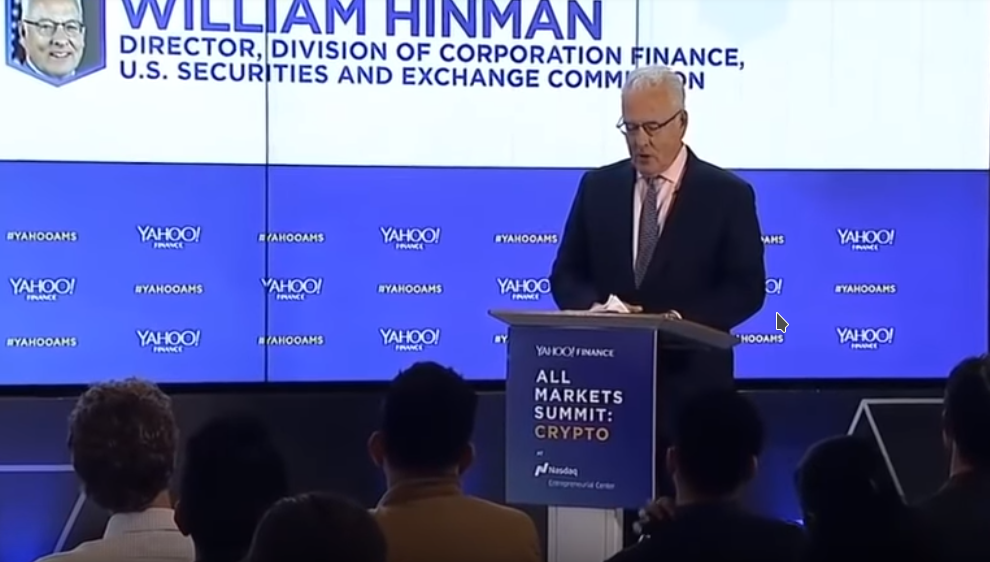The SEC is wrong. Ethereum is a Security.
The SEC is wrong! Ethereum is a Security.
Last month, director Hinman of the SEC’s Division of Corporate Finance SEC shocked the (legal) blockchain world with some peculiar statements during a speech. He stated that Ethereum, the cryptocurrency that fuels “the world computer”, is not a security. Instead, he believes Ethereum tokens stopped being a security sometime after its ICO. I believe he is wrong.


“putting aside the fundraising that accompanied the creation of Ether, based on my understanding of the present state of Ether, the Ethereum network and its decentralized structure, current offers and sales of Ether are not securities transactions. “
First, a few things to note:
- The SEC does not make law. They give guidance and enforce the law.
- Mr. Hinman did not say that Ethereum never was a security.
- He also didn’t say that ICOs are not securities offerings.
What he did say is that Ethereum is no longer a security. So, why do I think he is wrong?
The Howey Test — a really short intro to securities.
To answer this question, we have to put our lawyer hats on. We have to examine quite some case law on investment contracts, starting with Howey vs SEC. Let’s dive in.¹
In Howey-in-the-Hills vs the SEC, Howey sold citrus groves to its hotel visitors. The groves were then leased back to Howey under a service contract which stated that Howey would tend to the land, harvest it and sell the produce. The buyers of the real estate would then profit from the sale of the citrus’ harvest.
Although this was not technically an investment contract, it was held by the Supreme Court that the form of the relation between the parties should be disregarded in light of the economic reality. At the end of the day, investors were investing in Howey with an expectation of profits.
As such, the Howey-test was developed. According to this test, any situation that meets the following 4 criteria is considered to be an investment contract — and therefore a security:
- There is an investment of money
- In a common enterprise
- With an expectation of profits
- Resulting from the sole efforts of a third party
You might be thinking: Why does this matter?
Well, investors want to profit from their investments. As an investor, the success of your investment is dependant on the efforts of the issuer. To make an informed investment decision, you therefore want to have access to any important information about whatever it is you invest in. The law recognizes this. Hence, securities laws make sure that if a contract meets the four criteria of the Howey-test, the issuer has to file a so-called prospectus.
Simply said, in the prospectus, the issuer has to provide information about, for example, its background, financing, plans, financial stakes and risks.
Why Ethereum is not a security, according to the SEC
There is no question that, at the time of Ethereum’s ICO, investments in ethereum most definitely met all of the four prongs of the Howey-test. Everyone who participated in the ICO invested their Bitcoin, hoping for profits which would arise from the development of Ethereum, or in other words, from the efforts by the issuer of the tokens. So why would the SEC now say that Ethereum is no longer a security?


Mr. Hinman elaborated. He formulated this thesis as follows:
“If a network on which the token or coin is to function is sufficiently decentralized — where purchasers would no longer reasonably expect a person or group to carry out essential managerial or entrepreneurial efforts — the assets may not represent an investment contract. Moreover, when the efforts of the third party are no longer a key factor for determining the enterprise’s success, material information asymmetries recede. As a network becomes truly decentralized, the ability to identify an issuer or promoter to make the requisite disclosures becomes difficult, and less meaningful.”
Certainly, his reasoning makes sense.
Why would an investor need information disclosure about a party that no longer has any influence on the invesmtent which is acquired? Someone who buys a citrus (instead of the groves ) from Howey has no use of information about the operational, financial and management risks of Howey-in-the-hills itself.
Likewise, someone that buys Ether has no use for information concerning the Ethereum Foundation, if this foundation no longer has influence in Ethereum’s future. The fourth criterium of the Howey-Test (profits resulting from the sole efforts of a third party) would not be met, and, as such, Ethereum would not be a security.
If the future value of Ethereum no longer depends on the efforts of the Foundation, then the investor doesn’t need securities laws to protect him.
Why Ethereum is in fact a security
Although the thesis of the SEC is by itself reasonable, I believe it ignores the realities of Ethereum’s governance and the influence of the Ethereum Foundation, the issuer of the token, over Ether’s value.
For the SEC’s thesis to be valid, Ethereum has to be decentralized.
The application of the SEC’s thesis requires a binary decision (yes/no) on Ethereum’s decentralization. In practice however, this is very difficult. It is true that there is a degree of decentralization of Ethereum’s governance processes, development and ecosystem. At the same time however, the Ethereum Foundation still plays a large role. Where is the line between a centralized token and a decentralized one? How do we even measure decentralization? And is Ethereum decentralized enough to cross it?Most importantly:
Is the price of Ethereum still solely reliant on the efforts of the Ethereum Foundation and Ethereum’s founders?
First of all, we know from past case law, that the word ‘solely’ is not to be taken too literally.² In fact, the term is also interpreted to include significant or essential managerial or other efforts necessary to the success of the investment. Therefore, if significant or essential efforts from the Ethereum Foundation are required for the success of Ethereum, it is still a security.
We also know that a ‘possible enhancement in value at resale is not within the Securities Act, where the essential element of reliance on the managerial, operational or developmental efforts of others is not present.’³ The test in most cases is whether the efforts made by those other than the investor are the undeniably significant ones — those essential managerial efforts which affect the failure or success of the enterprise. As such, the question becomes as follows:
Are the efforts by the Ethereum Foundation and Ethereum’s founders the most significant efforts for the success of Ethereum?
Let’s go over a few relevant factors.
Ethereum’s governance
An obvious factor to take into account is the impact of the Ethereum Foundation on Ethereum’s governance. In theory, there is a substantial degree of decentralization here. Literally anyone can propose and contribute to code and any such new code will be voted on by a decentralized set of miners.
In practice however, I believe that a closer examination would show that a significant influence still resides with its issuers. Although empirical analysis is more suited to prove this, we know that the most important changes to Ethereum’s network (the implementation of Casper PoS as a consensus model, the rejection of on-chain governance structures and the DAO hard fork) were all a direct result of Ethereum’s core developers’ efforts.
All these changes have had a direct, measurable effect on the value of Ethereum. In fact, the DAO hard fork decision, which only came to be due to the efforts of Vitalik Buterin, has even led to Ethereum splitting up in two different assets: Ethereum and Ethereum Classic.
Saying that the Ethereum Foundation has no substantial role in Ethereum’s governance because they don’t make final decisions by themselves as the community is involved in the decision making process is like saying that a company’s board of directors has no influence over the future of the company because shareholders have a role in governance too…
Indeed, a substantial part of Ethereum’s success can be attributed to the cult-like adoration of its founder, Vitalik Buterin. He is seen by the entirety of Ethereum’s community as the kid-genius that has made Ethereum what it is today. To this day, his efforts to market, develop and form the Ethereum ecosystem are what makes Ethereum unique as compared to similar projects. It is these efforts that have given, and continue to give, Ethereum its competitive edge over other smart contracting platforms.


Ethereum’s Dependance on the Original Codebase and Efforts
In a case called SEC vs MBC, we learned that, while it may be true that the ‘solely on the efforts of the promoter or third party’-prong may be more easily satisfied by post-purchase activities, there is no basis for excluding pre-purchase managerial activities from the analysis.⁴
As such, we have to examine the degree of dependence of future profits on the original codebase, versus the degree to which profits arise due to future ‘decentralized’ efforts, at the moment of the investment. To do so, we have to know what gives Ethereum its value.
Since its inception, Ethereum has mainly served as a platform that allows developers to raise money for other tokens through Initial Coin Offerings. Without a doubt, this is the main use case of Ethereum and therefore the main source of value.
Now one could argue that, because each of these ICOs is developed by different parties, Ethereum’s value arises from the efforts of third parties. Again however, the reality is that the Ethereum Foundation and its core developers have had a huge influence here. They not only made it possible for other developers to launch tokens on top of Ethereum, they actively pursued this as the main goal of Ethereum. From the beginning, the whole design-philosophy behind Ethereum has been to make it as easy as possible to launch tokens on top of the network. The first thing one learns when learning Solidity (Ethereum’s smart contract coding language) is how to create a token. The second thing one learns is how to sell it to the general public.
